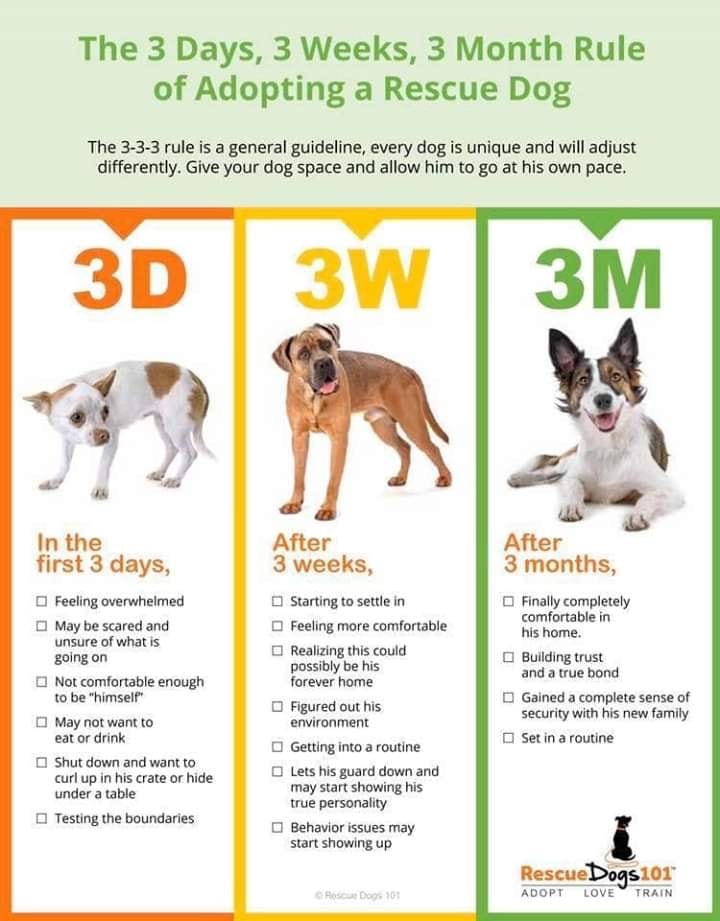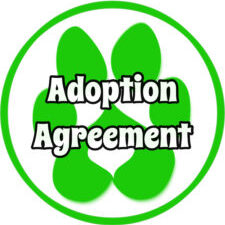The all too important Rule of Three! Credits to Rescue Dogs 101 for putting this important information together for others to share.

GETTING READY FOR YOUR NEW FAMILY MEMBER!
Essential Supplies:
Leash & Collar - A breakaway collar is a good choice for everyday wear. They are designed to unsnap easily if the collar gets caught on something so your dog doesn't get choked. For walks, at first we recommend the use of a slip knot leash so that your new family member does not slip out of a collar or hardness. Not until he/she is comfortable and trusts you do we recommend walking with a buckle collar or harness.
Food - Changing a dog's food abruptly can cause diarrhea, sometimes for several weeks. To avoid this, continue feeding the same food provided by the foster home, or mix the old with the new to gradually adjust your dog to a new diet. Instructions on switching to a new food as well as guidelines on how much to feed your dog and how often should be on the bag itself, however most dog food brands also have this information on their website. The best route to take would be slowly mixing current food with new food over the course of 4-5 days in 25% increments.
- Day one 75% current food and 25% of new food
- Day two 50% current food and 50% new food
- Day three 75% new food and 25% current food
- Day four repeat day three
- Day five you should be able to switch completely to the new food and just mix the current food in little by little til it is gone.
- If you have a large bag of current food you may want to mix 50/50 til it runs low then act as if on day three.
Food & Water Dishes - Pick a spot and leave them in the same place so your dog knows exactly where to go for water. Make sure the water bowl is clean and has fresh water at all times. You will also want to clean their bowls regularly to prevent bacteria build up.
Crate - Crates make the adjustment period less stressful for you and your new fur-baby. The crate should be big enough for your dog to stand up, turn completely around and lie down comfortably in. However, if the crate is too big your dog may have accidents in it, so pay attention to crate dimensions and the dog weight/height it is recommended for. Many people don't like to crate their dogs however what they fail to realize is that if used properly the crate can be a safe haven for your dog. They will more than likely take naps in it and use it for their own time out if they are stressed. It will also prevent them from getting into trouble or things that are unsafe for them. You never want to use a crate for punishment. The crate should only be used in a positive manner.
Toys - Safe toys help dogs ease stress and, of course, have fun! Having toys available will ease the adjustment period. Always supervise your dog when playing with toys. You can leave him alone with heavy duty toys like Kongs, but check for damage periodically to avoid choking hazards. We do not recommend toys with the plastic squeakers in them as the dog usually will rip them out and they pose a major choking hazard for your dogs. Rope toys are also dangerous if they are allowed to play with them unsupervised. Always check their toys for damages and if a rope toy is unraveling you will want to toss it because if they ingest it, it can become tangled in the intestinal track and can kill your dog.
Puppy Proofing:
Even if your dog is older, curiosity can get the better of him. Make sure your home is a safe place for him by putting yourself in his paws. Crawl around on the floor and check out any potential dangers. Electrical cords, poisonous houseplants, and any item small enough to swallow are just a few of the things that should be out of his reach. Veterinarians perform more surgeries to remove strange objects that a dog has swallowed than for anything else.
Even after puppy proofing, it's a good idea to not leave him unsupervised in the house until he has learned what is off limits. That way he won't have the chance to develop any bad habits while you're not looking! You'll also avoid having to buy all new shoes because he chewed up one from each pair. If your dog destroys something that is valuable to you, it is your fault for making it available to him. Dogs have no concept of how much something costs, and they don't chew things to spite you. They do it because it is fun. Dogs also chew to relieve stress, so a dog who normally doesn't chew things may do so when under stress. Make available appropriate chew toys and keep items you don't want chewed out of reach!
Meeting the Children:
The kids are probably beside themselves with excitement about the new doggie. They probably can't wait to play with him and show him just how much they love him. Prepare your children ahead of time so that they understand the boundaries.
- Take the time to educate yourself on dog behaviors and learn the warning signals dogs will give when they are uncomfortable. Just being able to read the signs and act on them can prevent a disaster from happening. Prevent your child from being attacked and prevent your dog from being euthanized. Most dogs will not bite without giving several warning.
- Let your children meet the new dog BEFORE he comes home.
- When the new dog does come home, keep him on leash and have your children sit down to say hello. Sitting will help them be calmer which will help your dog be more relaxed.
- Always supervise children with dogs, no matter how small the dog. This is for the safety of your dog and your child.
- Teach your children not to hit, ride, step on, pinch, pull, or squeeze the dog.
- If your dog is nervous, ask the children to give him a break until he gets comfortable with them.
- Don't let children feed your new dog until he is settled in.
- Don't let children put their hands or face near a dogs food or treats while eating.
- Don't let your children take the dog's toys, and don't let your dog take the children's toys.
- Don't let children walk the dog without adult supervision.
- Set up a "safe" place for your new pet that is off limits to children. A crate is great for this. Instruct the children not to try and play with him when he is in his safe place.
Meeting the Other Pet(s):
Hopefully, the pets you already have are just as excited about the new addition as you are. Here are some tips to help make sure of it.
- This may seem strange however we recommend not letting your dogs meet face to face. Instead turn them backwards one at a time and allow the other dog to sniff the exit zone for a couple of seconds 5 at most and then switch roles and allow the other to be the exit zone sniffer. This is how dogs learn pretty much all they need to know about another dog.
- Let your pet(s) meet the new dog BEFORE he comes home, if possible. We recommend taking the dogs on a walk together so they begin to feel like a pack.
- When the new dog does come home, re-introduce all pets with the new dog in a crate for safety. Wait until all pets are calm and relaxed, even if that takes several hours, before introducing each pet on leash. Watch for signs that either pet is stressed, and separate if necessary. Do not try to push them to be friends too fast. Slower is better!
- Don't change the routine for the resident pet.
- Crate the new dog periodically to give your resident pet a break, especially if he seems stressed or annoyed with the new dog. Your new dog may spend a lot of time crated in the first week or two, but a slow introduction is better in the long run for everyone.
- Spend time individually with the new dog and the resident pet.
- Supervise playing with toys to prevent spats. Providing one more toy than there are dogs is a good practice. This way, if one dog gets tired of a toy, there is an option other than stealing from the other dog. Wait a couple of weeks before giving them something of high value such as a stuffed bone.
- Enforce the rules right away with the new dog. Dogs thrive on rules and consistency. It can make them anxious if another pet breaks the rules.
- Even if the resident pet is not a dog, many of the same tips apply. Supervise all interactions. Observe all pets for signs of stress and separate them to give them a break. Cats should always have a quick escape route!
Adjustment Period:
Moving to a new home can be stressful for dogs. It's an unfamiliar place with unfamiliar people. Some dogs experience stomach upset and diarrhea. House-trained dogs may regress and have accidents. Some will shy away from you for a while until you earn their trust. Be patient with your baby. It may take a while for him to adore you as much as you adore him. How long it takes is different for every dog. It could take anywhere from three days to three months for your new dog to settle in. Just be patient with him and show him in all of your actions that he is safe with you. If you are having any problems or have any questions during the adjustment period about a dog you adopted from Pet Path, please do not hesitate to contact us. We will do everything we can to help ease the adjustment period for both of you.
If you're adopting a puppy rather than an adult dog, expect an adjustment period for yourself, too! Adopting a puppy is like having a baby. There will be lots of potty breaks because their bladder isn't yet fully developed. Expect to get up a couple of times during the night for potty breaks. If you work, plan to come home everyday at lunch to let your puppy outside to potty. If you can't come home, consider hiring a pet sitter. Or, use an X-pen instead of a crate and set up a potty area on one side. Just know that a puppy HAS TO potty several times a day and plan accordingly. We recommend writing down every time the dog goes potty (both outside and accidents) so you can begin to see their patterns and how frequently they need to go out. Puppies will also chew on everything available, so don't make anything available that he shouldn't chew on.
Establishing the Rules:
It can be tempting when you bring home a new dog to be a little lax on the rules. Resist the temptation now so you can avoid problems later on. It's much easier to prevent a bad habit from starting than it is to break one. Not only that, but dogs, like children, like rules and structure. It makes them feel more secure to know exactly what is expected of them and exactly what happens if they don't follow the rules. It also keeps order in the household. If you have other pets who already know the rules, they can get quite stressed out by an unruly newcomer. Whatever you do, do NOT feel sorry for your poor little rescue dog. Nobody wants pity, dogs included. For your dog's best interest, put whatever sad past he may have had behind him and live in the current moment. He's with you now, happy and cared for; he has no need for pity.
- Do not leave your new dog unsupervised in the house unless he is crated until he has learned the rules. This way, you can prevent bad habits from forming. If you don't see him, you can't stop him!
- No unsupervised time unless crated also helps with house-training. If he doesn't have a chance to make a mistake, the bad habit won't form.
- If you don't want dogs on the furniture, don't let him on the furniture just because he's new.
- Expect your dog to break the rules frequently in the beginning. He is not being stubborn or difficult. Dogs have a hard time generalizing, which means that something he learns in the living room will have to be learned all over again in the kitchen and again in the bedroom. It's easy to get frustrated when you feel like he should understand already, but he still doesn't. It helps to have a sense of humor. It can take 30-50 or more perfect repetitions before a dog truly "gets" a command.
Licensing & Identification:
If your city requires dogs to be licensed, get this taken care of right away. Licenses can usually be purchased at the Vet's office. Even if your city does not require a license, it's a good idea to provide contact information on your dog's collar. If your pet is lost or stolen, microchipping is a good way to ensure his safe return. Collars can come off, but microchips are there to stay. Dogs adopted from Pet Path are microchipped prior to adoption - You will need to register the chip under your name. We will also have the chip registered to Pet Path as a back up. Please note that microchips can move and have been seen via x-rays in places most would not know to scan such as the chest cavity or even down into the leg area.
Training & Behavior:
Just like children, dogs need to be taught good behavior. Whether you're bringing home a puppy or an adult, you can expect that he will do some things that you don't approve of and maybe have some bad habits. Your dog will need to be taught how you want him to behave. The easiest and most fun way to teach your dog is to take him to "school" (training classes). You both get to meet other people and dogs. You get the benefit of expert knowledge and immediate feedback. Your dog gets socialization. Both of you may even make a new friend there.
You can also work on teaching your dog yourself. There are lots of resources available, but it can be difficult to determine which information is bad and which is good. If your dog has habits you'd like to break, don't give up on him. Teach him instead! Consistency and persistency are key. Be consistent with your verbal cues and hand motions - "sit" and "sit down" sound very different to a dog. One word commands combined with a hand signal are best! Be persistent with your training and set aside time to practice every day until (and even after) your dog reliably responds to your commands.
Training also makes dogs happy. Studies on the brain show that animals like to have their brains challenged. The mental exercise can be just as rewarding (and exhausting) to your dog as physical exercise. As long as you use positive methods to teach your dog, he will LOVE learning. Training also helps your dog understand that they are supposed to take direction from you.


